Every now and then, our travels across Thailand take us to some epic places. Some old-school places. Some way off-the-beaten-path places. Some oddball places.
And now, a disappointing place — the first one since a 2012 visit to the Gimpo Tea Etiquette Museum.
Sukhothai has one major attraction: the Sukhothai Historical Park. Listed as a UNESCO World Heritage Site in 1991, it brought an influx of tourism that has changed the town — for the worse. There’s an unusually aggressive group of tuk-tuk drivers you’ll first meet at the bus terminal, who are happy to show you their book of hotel business cards and rip-off tourist pricing for the uninitiated. Their map is quick to emphasize the supposed 3 kilometers from the bus terminal to town, but doesn’t show the walkable path that puts you there in 10–15 minutes.
Because the Historical Park is so touristy, we weren’t all that interested in seeing it. Instead, our plans revolved around the weird destinations around the town (as you might have guessed).
Our first stop is Wat Thawet, a older-looking sort of hell temple:
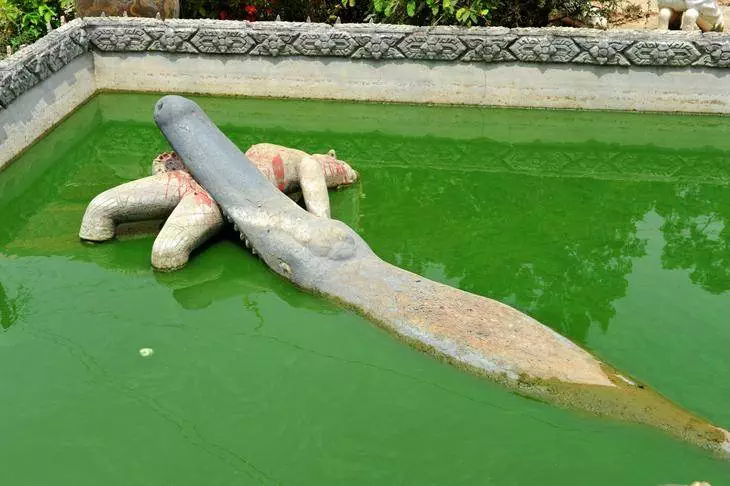
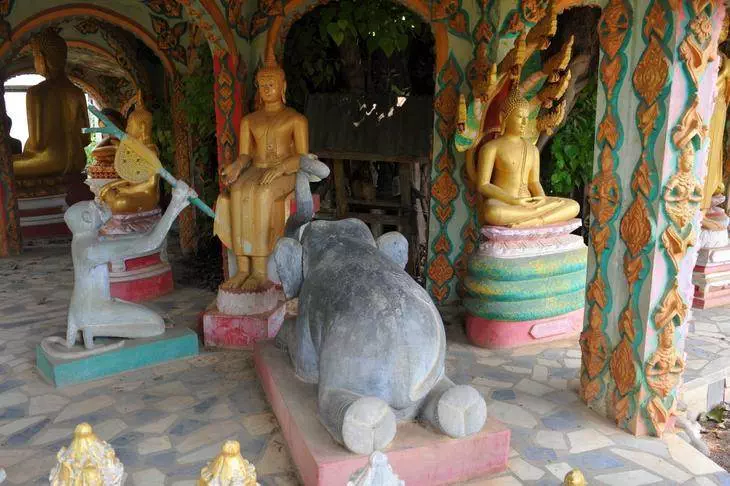
Euphemistically called a ‘learning garden’, the temple was started by Phra Sumroeng Thamanantho. In 1976, the monk single-handedly started the hell garden by recycling what he could. Between planted teak trees and the occasional bench, there’s around a hundred different, brightly painted, concrete statues occasionally being repainted or fixed. Phra Sumroeng’s son has continued in his father’s footsteps, though on our visit very few monks were around.
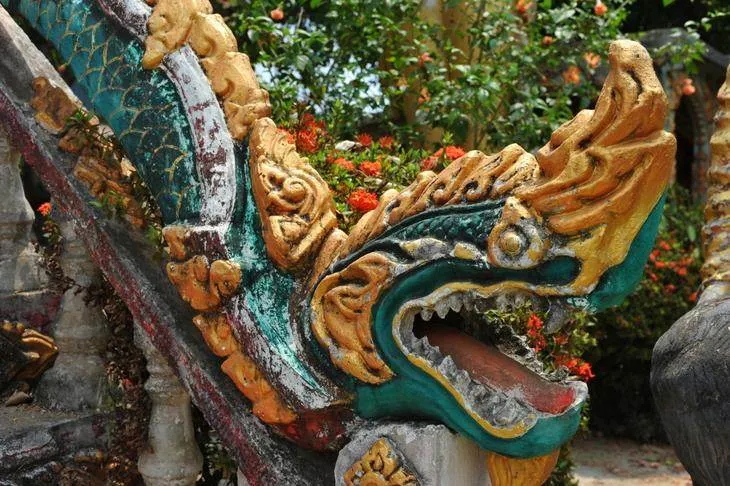
One of the naga along a staircase.
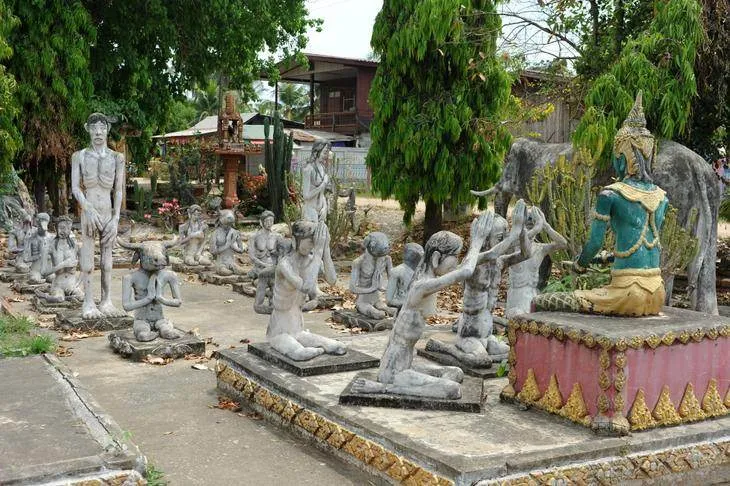
Prayers for salvation…
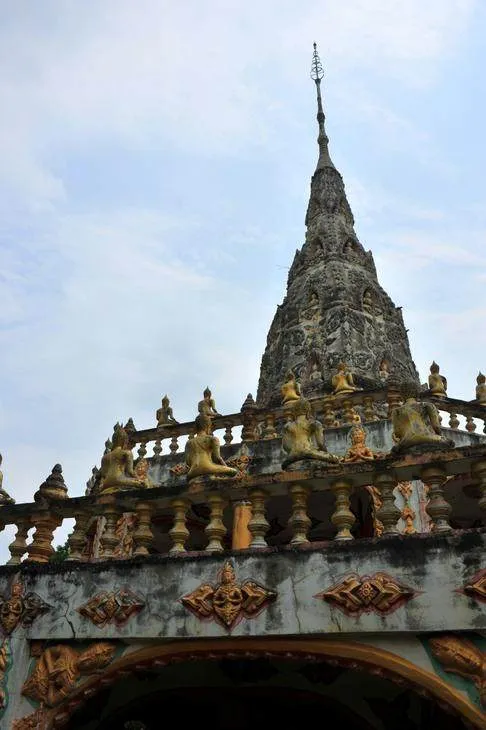
A look up at an intricately designed tower…
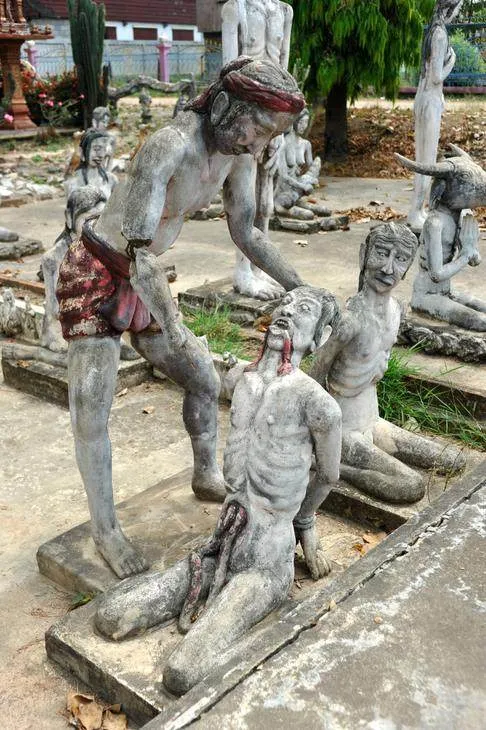
…And a look back down at some of the punishments.
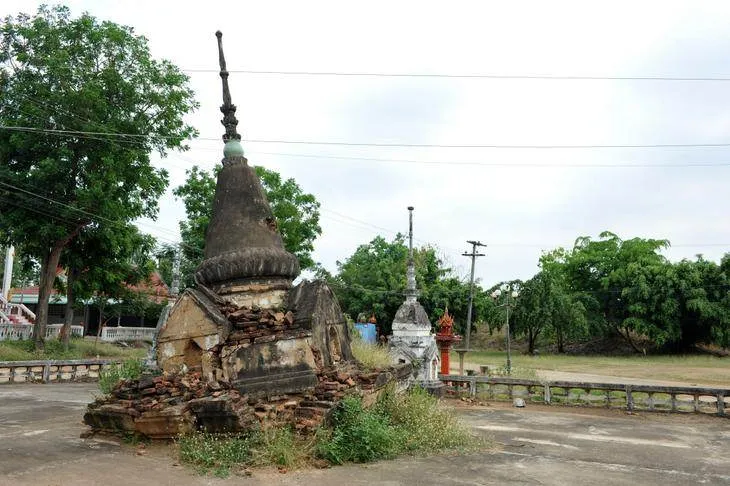
Whoops… Always awkward when the ground sinks beneath you.
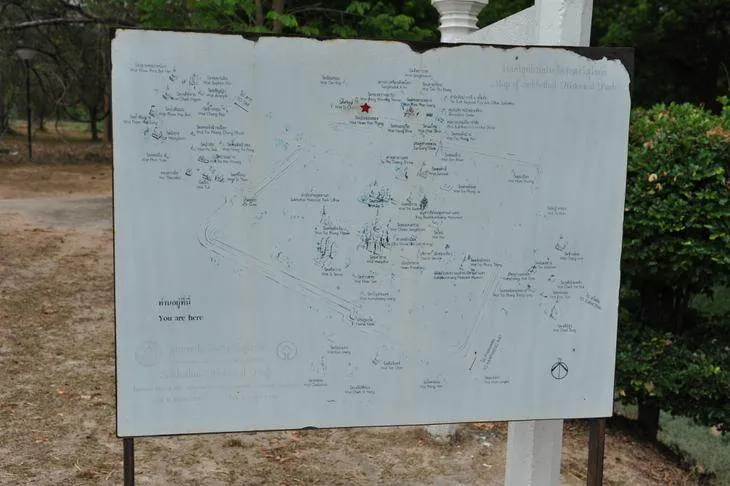
Our next stop was the Ramkhamhaeng National Park, more specifically the Fish Museum (called พิพิธภัณฑ์ปลาในวรรณคดีเฉลิมพระเกียรติ in Thai)… Yep. Closed. The sign indicates it’s closed for repairs or renovation. It’s hard to say much more than that, Except to say it’s supposed to be open daily except Tuesday from 9am-5pm.
Next up, we aimed our rented scooter at Wat Si Chum, near the historical park:
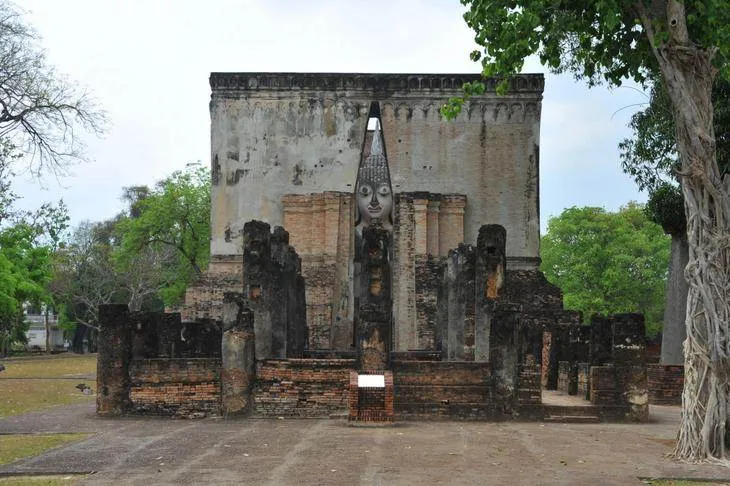
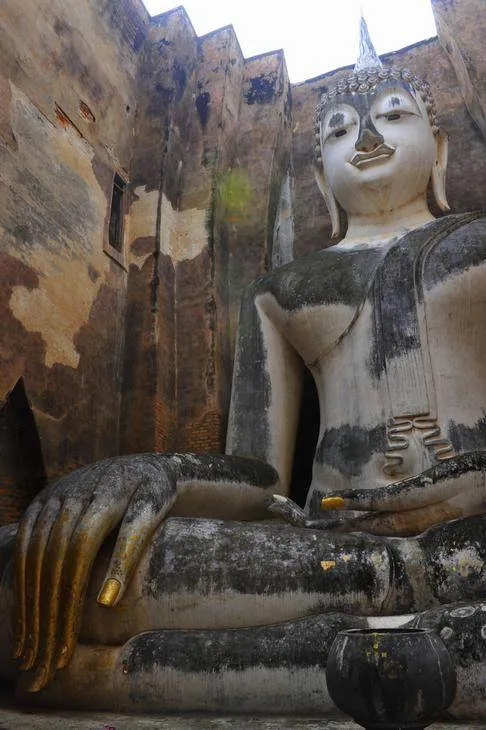
Now that’s One Big Buddha — Phra Atchana at Wat Si Chum. There’s also supposed to be 700-year-old faint paintings, 50 engraved stone slabs, and a hidden passageway to make your voice sound like it’s coming from the Buddha…
Except there’s two tiny problems.
- First, these remnants will cost you 100 baht to get in. It’s part of the ‘Northern Zone’ of the Historical Park, and it’s a mere 20 baht for Thais. Being part of the Northern Zone means there’s some other remnants and relics to see, and you’ll need some of these dilapidated maps to find your way.
- Second, those faint paintings, stone slabs, and the hidden passageways? Off limits. What you get for 100 baht is the chance to visit the Big Buddha. That’s it. Asking the crocheting ticket taker why simply led to an indifferent ‘I don’t know’. I’m pretty sure she didn’t break stride or lose a stitch.
For what it’s worth, the Big Buddha rests in the ‘Subdoing Mara’ pose, a symbol of unwavering strength and stability. The most obvious element, beyond the 15-meter tall, 11.5 meter-wide image, are the elegant golden fingers taller than most people.

Like a Buddha in a bathtub…? A smaller, former temple is to the right of the Big Buddha.
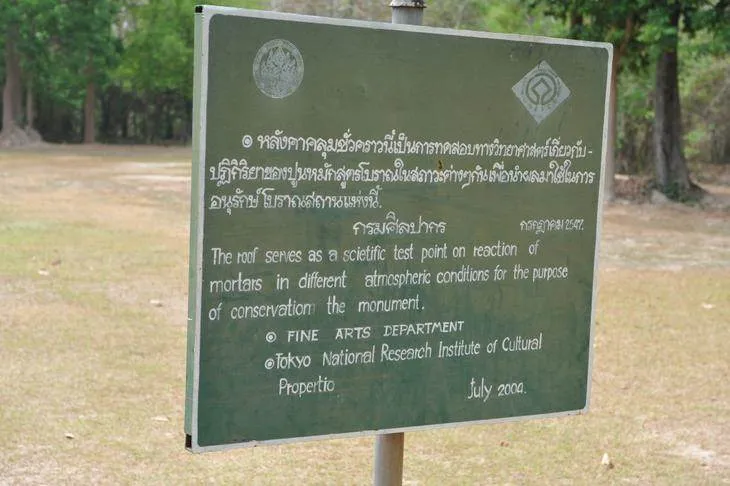
A mystery here — the sign is next to the aforementioned Buddha — the one with no roof. I sort of hoped the Fine Arts Department would have had a slightly better command of the English language — especially when foreigners pay 5 times the local price.
A little distraught, we stopped by the Phra Mae Ya Shrine (ศาลพระแม่ย่า) before returning the motorcycle and leaving town:
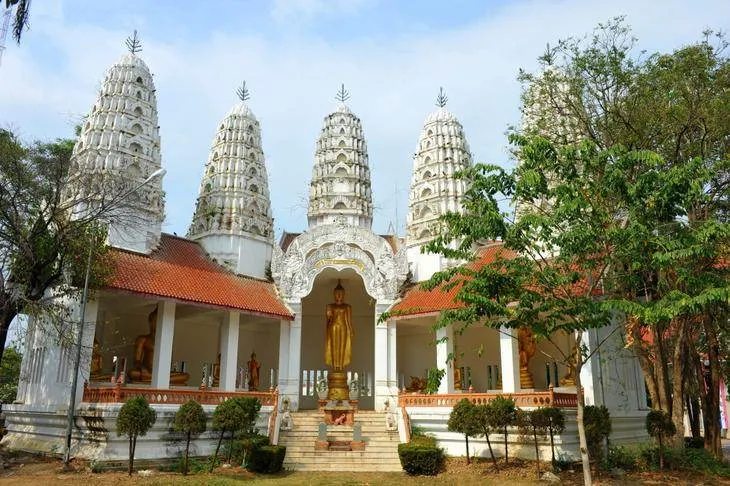
Revered and respected by the locals, we were the only foreigners around. Inside the main building is a stone figure of Phra Mae Ya (literally ‘grandmother’), dressed as an ancient Queen and built as a dedication to King Ramkhamhaeng’s mother, Nang Suang. The shrine also houses the spirit of King Ramkhamhaeng the Great, but since there were plenty of folks praying, we opted to put the cameras away and appreciate the scene.
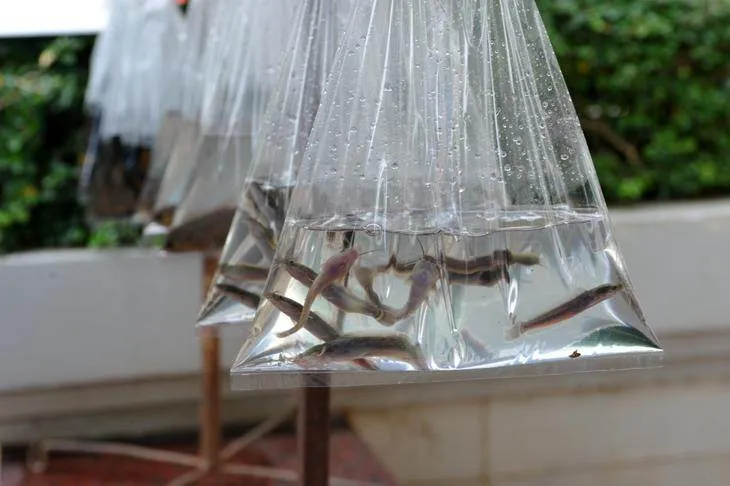
Make merit by purchasing some fish, then releasing them in the nearby pond.
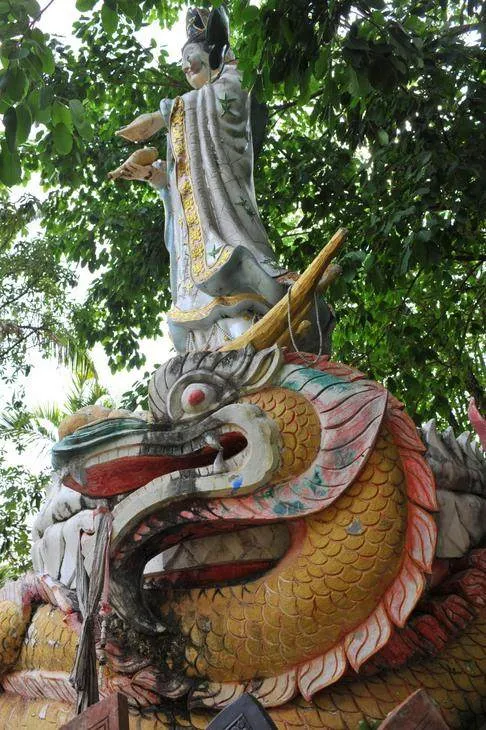
Another shrine behind the main one, but with no one around.
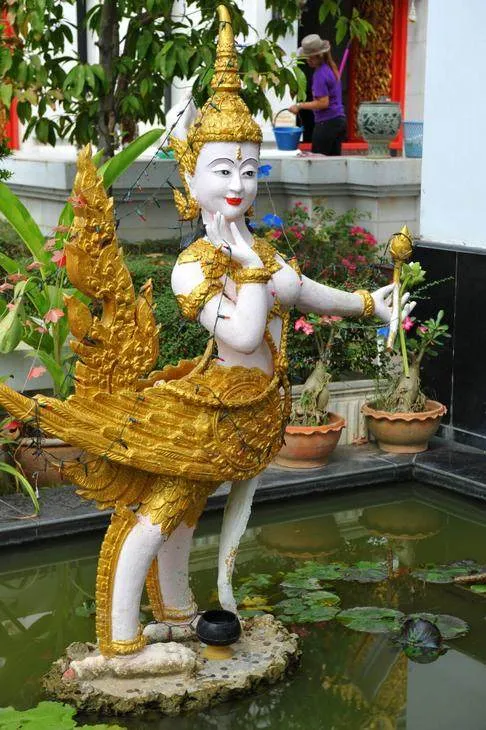
Another shrine to Phra Mae Ya? There was very little in the way of signage…
As a whole, I left Sukhothai with a sour taste in my mouth. The only city with more aggressive tuk-tuk drivers has been Bangkok, and even they weren’t that organized… Finding a scooter to rent required visiting a few different places, one of which lied to my face about having some for rent (unless the owners of two different motorcycles parked their bikes inside the open-air lobby and left their keys in the ignition)… The dual pricing scheme seems to start and end with the Sukhothai Historical Park, thankfully, and Wat Thawet is worth a brief visit. One interesting stop doesn’t make the town worth visiting.
Name: Wat Thawet
Address: Along route 101, Tambon Thap Phueng, Amphoe Si Samrong, Chang Wat Sukhothai 64120 (GPS: 17.080907,99.838293)
Directions: You’ll want your own transportation for this one. From the Sukhothai Bus Terminal, head to the main road, route 101. Turn right, then go about 2 kilometers to a four-way intersection. Turn left to stay on route 101, then go about 7 kilometers to route 12. Go straight through the other highway and go another kilometer — look right for the temple.
Hours: Not posted — daytime hours are probably safe.
Admission: Free — donations requested.
Phone: none
Website: none
Name: Sukhothai Historical Park / Wat Si Chum
Address: Tambon Muang Kao, Amphoe Muang, Sukhothai Province (GPS: 17.018645,99.703995). For Wat Si Chum, head to GPS: 17.026381,99.693049
Directions: Any tuk-tuk can get you there for 150 baht or more; a tour is possible for 700 baht or so. Rent a scooter, though, and save yourself some money. From the bus terminal, get to the main road (route 101) and take a left. Go about a kilometer and turn right onto the highway through town (route 12). Head west and follow the signs for about 7.5 kilometers. Bear left onto route 1113, and keep following the signs — this is the biggest destination in the area and is well-signed.
Hours: 6am-6pm
Admission: 100 baht per zone for foreign tourists; 20 baht per zone for Thai tourists (and presumably Thai residents who can show work permits). There are three zones and a musuem, which is 150 baht.
Phone: 055–697–527
Website: finearts.go.th
Name: Phra Mae Ya Shrine
Address: Nikorn Kasem street, Tambon Thani, Amphoe Mueang Sukhothai, Chang Wat Sukhothai 64000 (GPS: 17.005252,99.825655)
Directions: This is bikeable from the central city area / Mueang Sukhothai Park, also the same area as the night market. From the park, get there from Nikorn Kasem street, which follows the river. It’s about a kilometer from the park, and will be on your left.
Hours: Not posted — daytime hours are probably safe.
Admission: Free
Phone: None
Website: None


